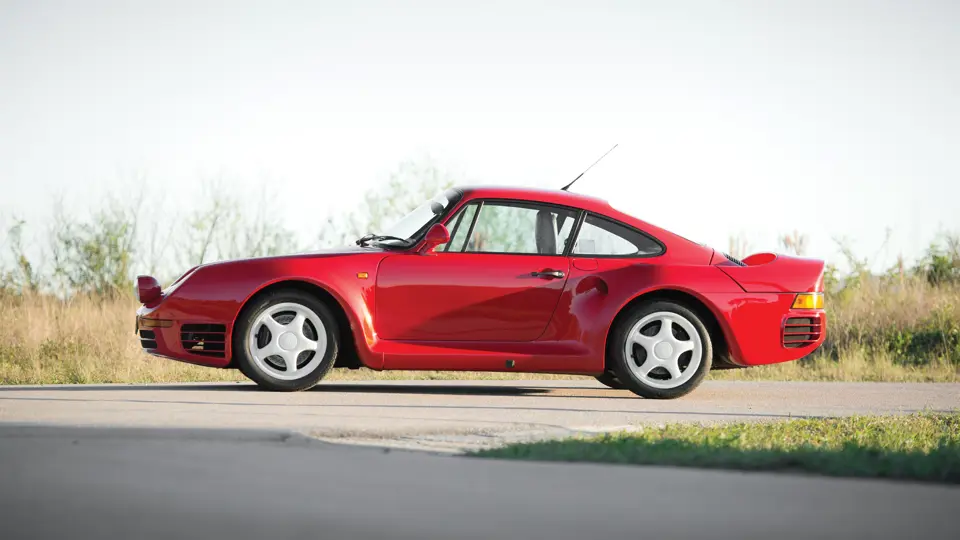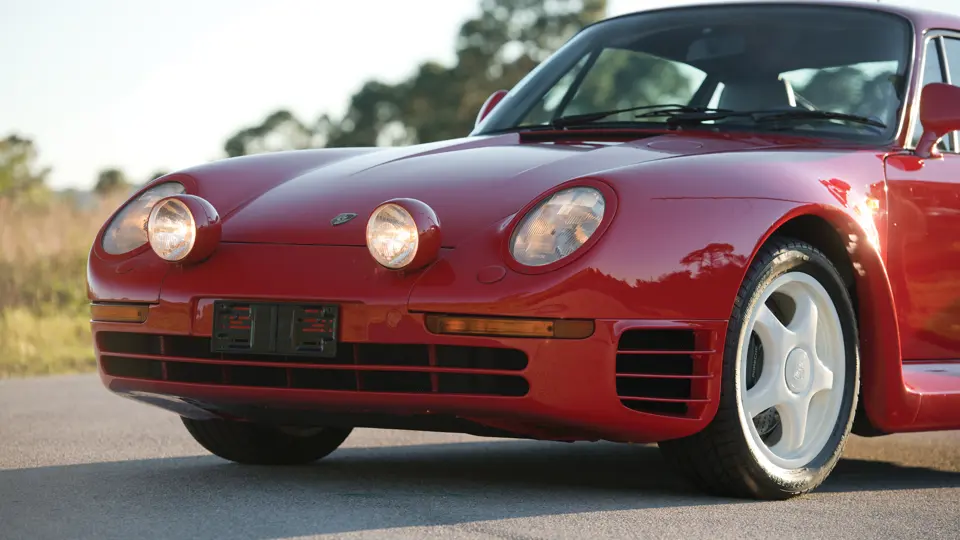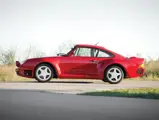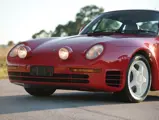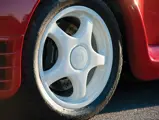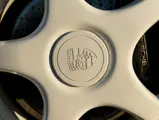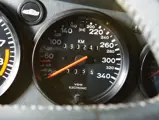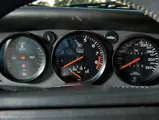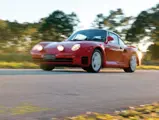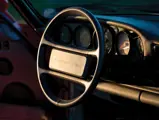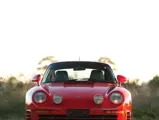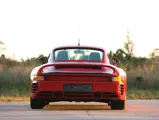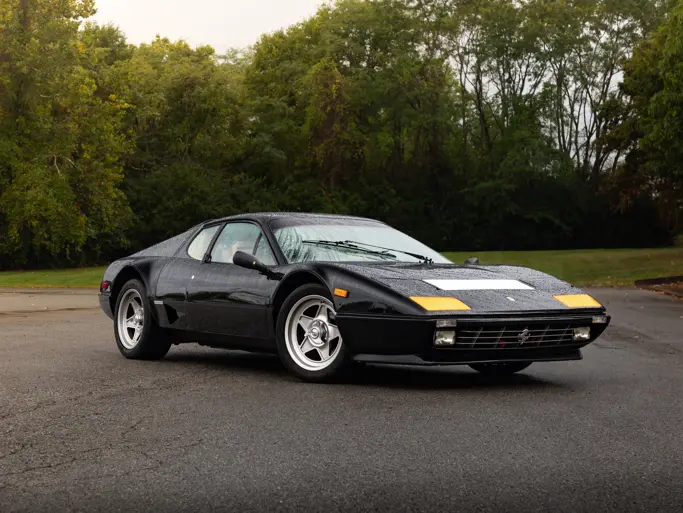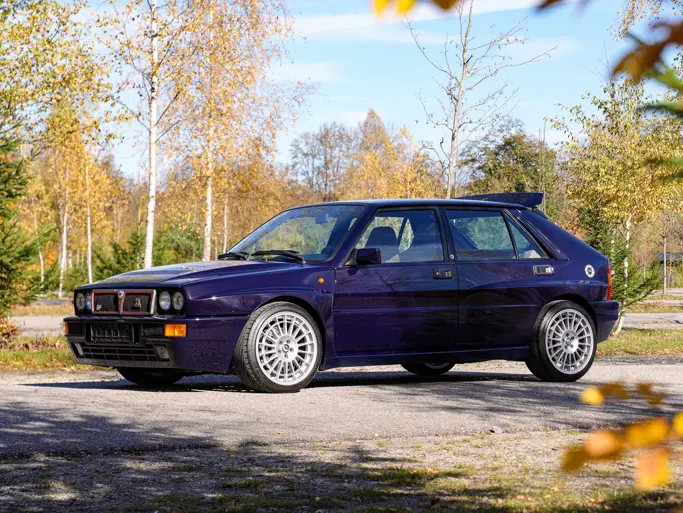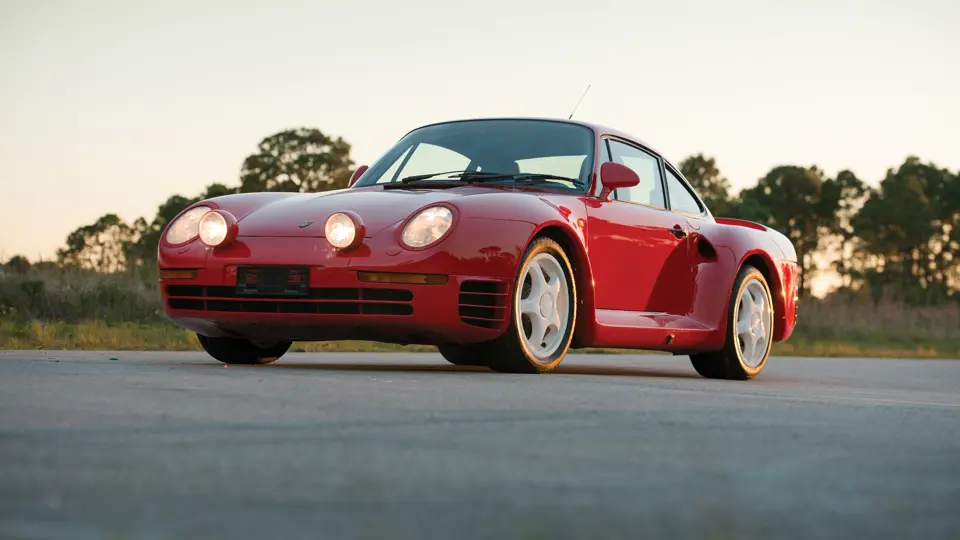
1986 Porsche 959 'Vorserie'
{{lr.item.text}}
$687,500 USD | Sold
{{bidding.lot.reserveStatusFormatted}}
- One of 21 pre-production examples
- Factory demonstrator until 1989
- Complete factory rebuild to production Komfort specification
- Documented and always serviced by Porsche
- Only two private owners from new
- The fastest and most technologically advanced road car of its time
450 bhp, 2,849 cc DOHC air/water-cooled horizontally opposed six-cylinder engine with twin turbochargers and electronic fuel injection, six-speed manual transmission, all-wheel drive, front and rear independent suspension with upper and lower A-arms, coil springs, dual shocks, adjustable ride height and damping, and front and rear disc brakes. Wheelbase: 89.5 in.
It has been said that Porsche’s revolutionary Type 959 Coupe was and remains one of that company’s most groundbreaking achievements. The 959 was the culmination of a dream harbored by Porsche’s then chief engineer, Helmut Bott, who was trying to find a way to keep the 911 series in production years into the future. Bott convinced new Managing Director Peter Schutz that developing a state-of-the-art 911-based chassis for Group B rallying would ensure a steady flow of improvements, such as all-wheel drive, which became the company’s most important product. The radical Gruppe B supercar prototype was unveiled at the 1983 Frankfurt Auto Show to great acclaim.
The cabin of the stunning new coupe was clearly identifiable as a 911, but both the nose and tail were drastically modified for aerodynamic efficiency. The Gruppe B Porsche featured a computer-controlled AWD system, along with suspension that could be adjusted for varying road clearance, which was an imperative for off-road competition. The 2.8-liter, flat-six engine was still mounted in the tail, but it was a true racing unit, with double overhead cams on each bank, a pair of sequentially operated turbochargers, and electronic fuel injection.
The cylinders were air cooled, but the cylinder heads themselves were water cooled. This was a practice that was first developed for the company’s 935 Le Mans racing engines. Later, it was advanced further for the company’s ill-starred Indianapolis project, and then it was plugged into the Type 961, the 959’s racing sister. In street form, this engine produced a conservative 450 horsepower at 6,500 rpm, with 370 foot-pounds of torque at 5,500 rpm. The sequential turbochargers allowed for a relatively seamless delivery of power from low rpms, virtually eliminating the “turbo lag” that was common to single-turbo engines of the period.
The rest of the drivetrain was of an equally brilliant design. The transaxle contained five forward speeds, plus a special, extremely low G gear for off-road use and the usual single reverse cog. The chassis featured automatic ride height options, adjustable shock absorbers, and a traction-control system that allowed torque to be varied between the front and rear axles. The 959s were fitted with 17-inch diameter, Denloc magnesium-alloy wheels, which were eight inches wide in the front and nine inches in the rear. These special wheels featured hollow spokes and a pressure-monitoring system, making the 959 one of the first models to use this technology.
The bodywork was also highly advanced for its day, as plastic body panels that were reinforced with glass-fiber and Kevlar were used, as well as aluminum framing and doors. The floorpan was a composite material that was lined with fire-resistant Nomex. All of this made for a very robust and rigid body shell, and it helped the 959 achieve an amazingly low curb weight of less than 3,200 pounds in street trim. Under hard acceleration, the 959’s torque-biasing system shifted up to 80% of the available torque to the rear-drive wheels, allowing this fabulous machine to hit 60 mph in less than four seconds, a stunning number for the day, and a top speed of nearly 200 mph. Dazzled reviewers gave this extremely radical and sophisticated package top marks for on-the-road behavior. The UK magazine Car espoused, “Push the throttle to the carpet and the engine note would deepen as the two turbos delivered more boost, and the car would jump. The danger threshold, we thought, was passed at about 185mph, 12mph short of the car’s true maximum.”
The sudden and unexpected demise of the FIA’s Group B Rally Championship left Porsche in a precarious bind, as it had already committed to building the minimum of 200 examples required for homologation, and it had invested a great deal of resources and stature to the project. Production had to go forward. The production 959 would therefore be offered in two versions, the Komfort, which included air conditioning, leather sports seats, and numerous power accessories, and the lighter-weight Sport, which lacked those accoutrements.
Every one of the 200 was instantly spoken for, even at the impressive base price of more than $225,000, which still did not come close to the company’s cost of production, resulting in the 959 becoming known as “Porsche’s gift to its best customers.” Some wealthy enthusiasts who didn’t make the initial cut took out ads in German magazines, offering huge premiums to take over the scarce contracts. The first customer car was delivered on the last day of April in 1987, to Dr. Wolfgang Porsche, Ferry’s youngest son, who, it was soon reported, was cited for excessive speed on a nearby autobahn. In 1987, the late Jerry Sloniger wrote, “As an automobile which proves how racing can improve the breed, each 959 will also feed technology into their lesser models for two or three generations to come.” This was a prediction that has proven to be uncannily accurate.
Demand exceeded supply, as Excellence Magazine’s Ian Kuah quoted factory sources as stating that 300 cars were eventually built, while other sources stated that the total may have reached some 330. It appears, however, that, along with 16 prototypes, there were 21 pre-production, or Vorserie, examples built in 1985. Regular production continued through 1988. In 1992, eight more cars were reportedly built from spare parts, and by this time, the list price had almost doubled. Because Porsche did not care to crash-test any of these incredibly valuable automobiles, 959s could not be imported for street use in the U.S. That is until a couple of influential technophiles, notably Bill Gates and Paul Allen, convinced the government to establish an exception for very limited production cars, which was known as the Show and Display law. Under this directive (often referred to as the Bill Gates Rule), a certain few models could be legally imported with annual mileage restrictions. Others were eventually significantly modified at great cost by their owners to meet federal regulations. Today, however, 959s are 25 years old, making them exempt from DOT and EPA jurisdiction, and they can now be imported and registered in this country without federal restrictions.
The magnificent pre-production 959 offered here was first registered in 1986 in Stuttgart, where it was displayed and made available to prospective customers at the Porsche Zentrum sales facility. It was used as a factory demonstrator until 1989, at which time it had accrued approximately 50,000 kilometers. Impressive documentation accompanying the car states that it was treated to a complete overhaul at the factory in 1989, which resulted in a virtual remanufacture. It was then sold by Porsche to its first private owner, Bertram Lehnan, who is understood to be a cosmetics industry executive from Brueggen, a few hours’ drive from Stuttgart. A letter from the factory to Mr. Lehnan, dated March 20, 1989, states that the car was given a “new drivetrain, new wheels and tires, a new hydraulic system, all the electrical components were overhauled to newer series specification, new sport seats installed in leather, including motor completely overhauled, rear axle and suspension overhauled, front transaxle” and more.
A factory air-conditioning system was retrofitted for Mr. Lehnan’s comfort in 2000. Mr. Lehnan kept the car until 2010, with the car’s service records intact, indicating that he added a mere 9,000 kilometers to the car’s total. At that point, the car was sold to its second private owner, who was identified by the car’s factory service records as a Swiss, Paolo Morigi. This gentleman added only another 1,000 kilometers, according to the car’s service file.
This rare 959, finished in stunning Porsche Guards Red with a pair of correct “tri-tone” silver sports seats, has been recently imported, and it is offered now with a clean U.S. title, which indicates that it is a 1986 model. The car has been fully serviced and detailed, and an RM representative has described it as being in spectacular mechanical and cosmetic condition. It is equipped with unusual factory-installed driving lights, and it is accompanied by its original manuals and related service books, a thick service file, and a tool kit, jack, and tire inflator, which are all unused and packaged in their original bags.
Type 959s come to market very infrequently, and this beautiful example, boasting a complete factory refurbishment, with low mileage since (approximately 10,000 kilometers), and fully documented history, presents an unusual opportunity to acquire a pristine example of an automobile that certainly ranks among the greatest road cars ever produced.
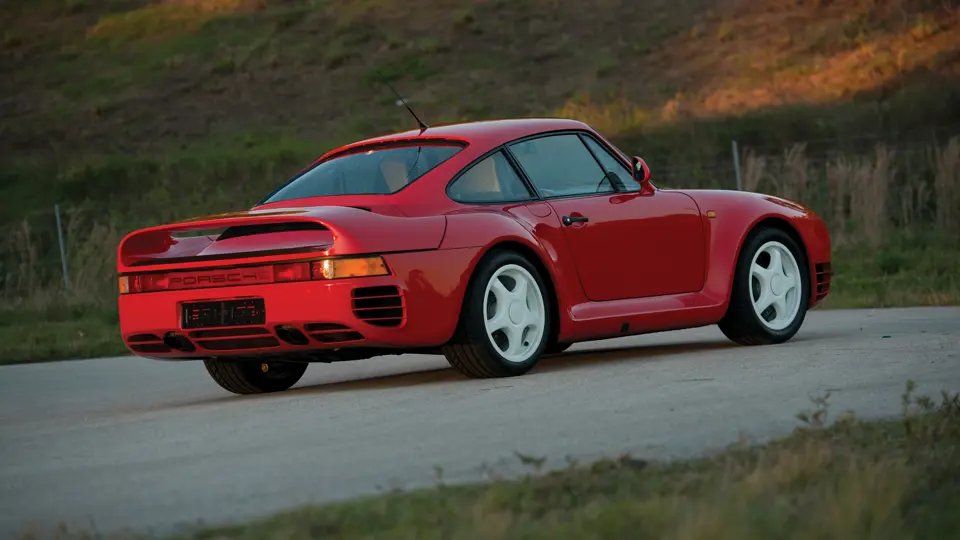





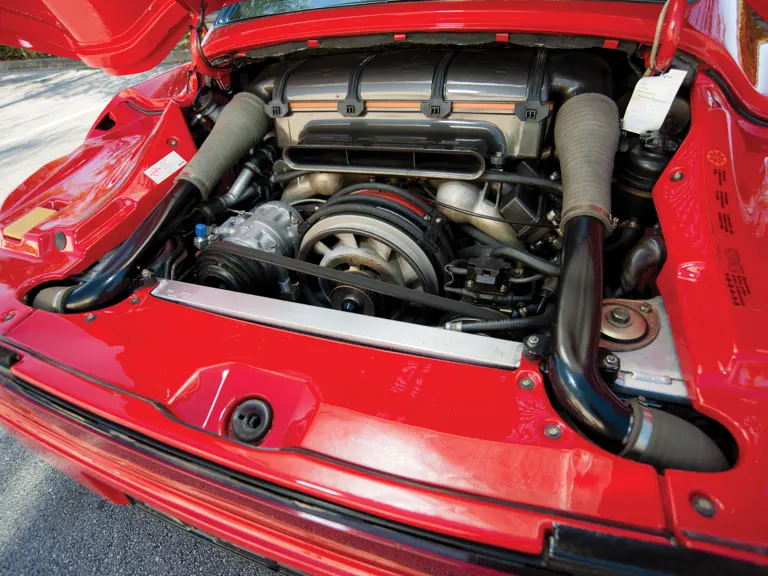
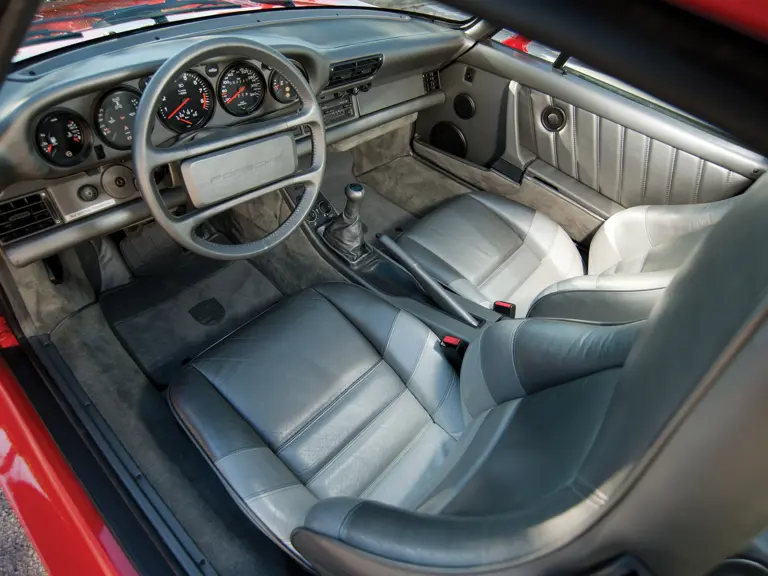

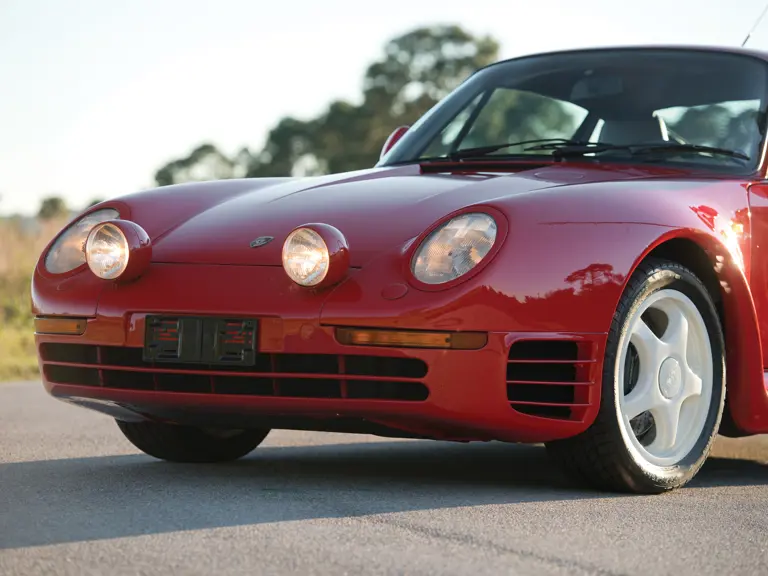
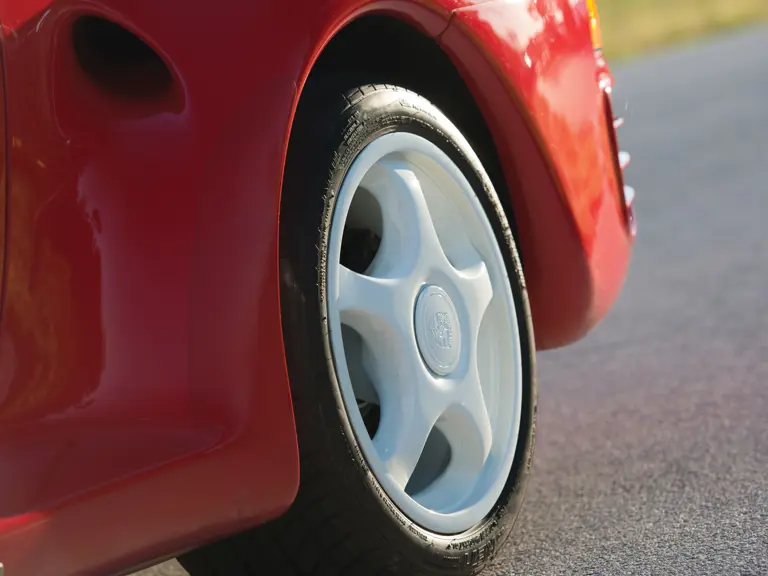

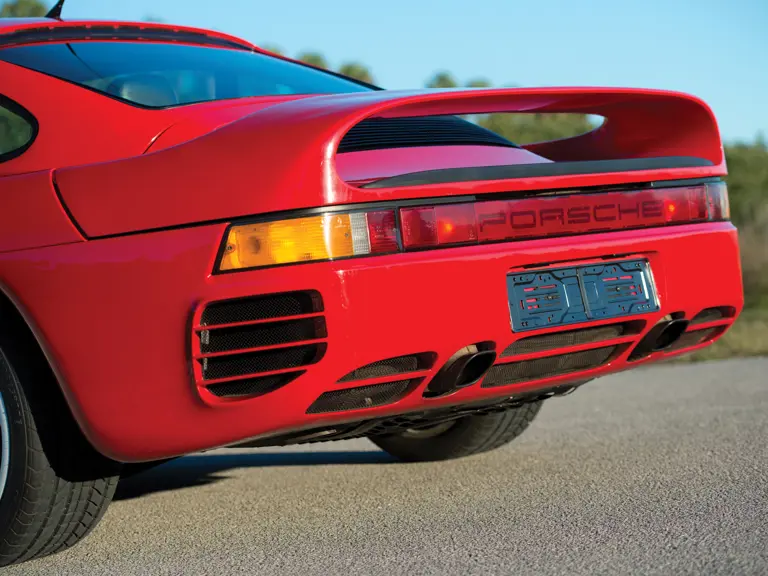
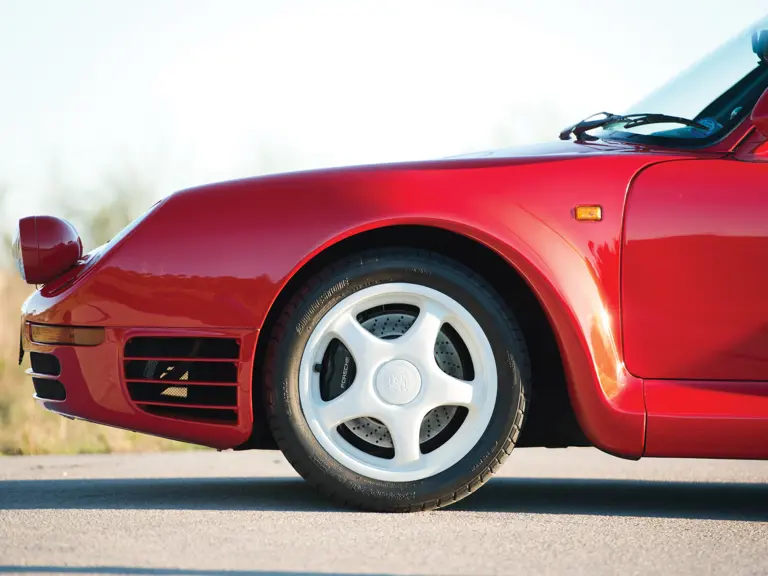

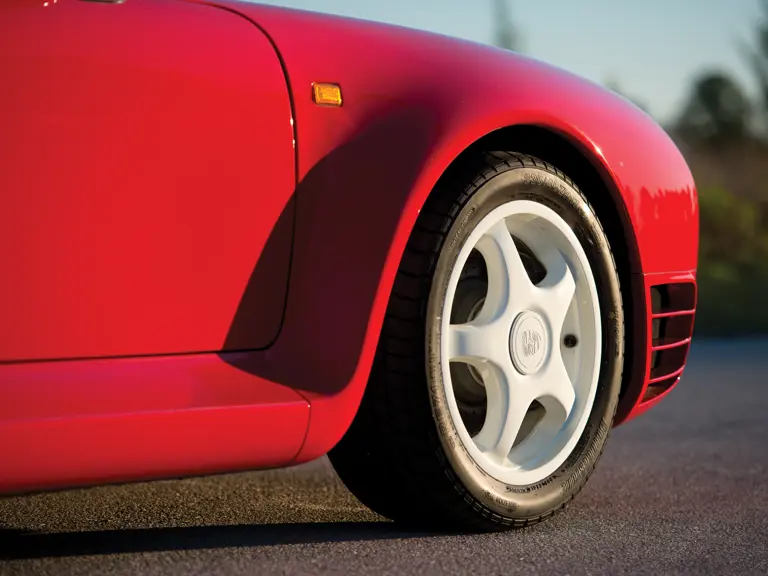

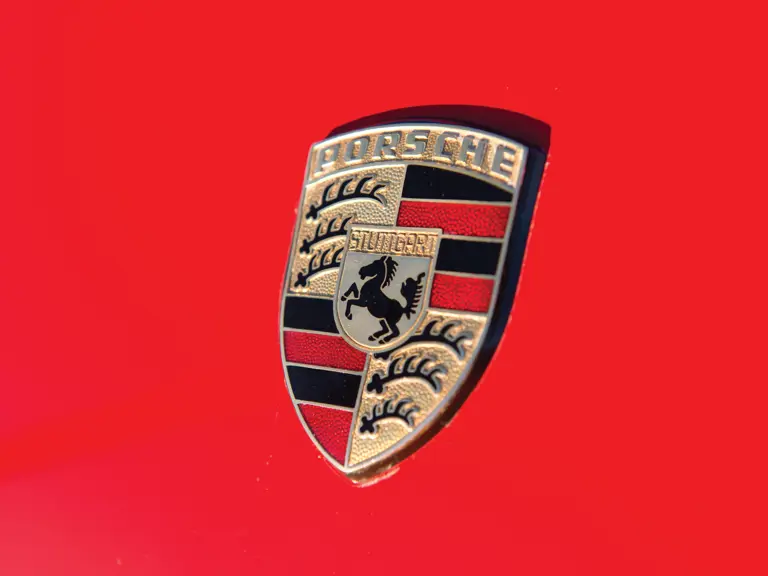

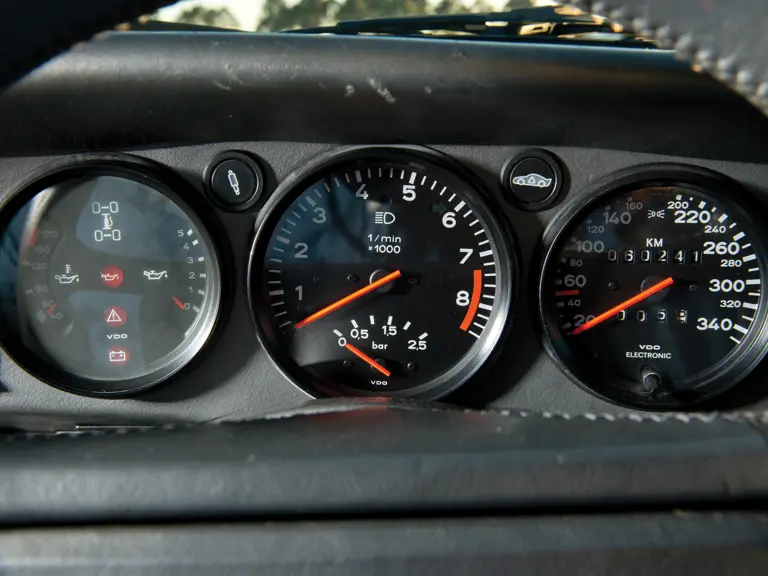
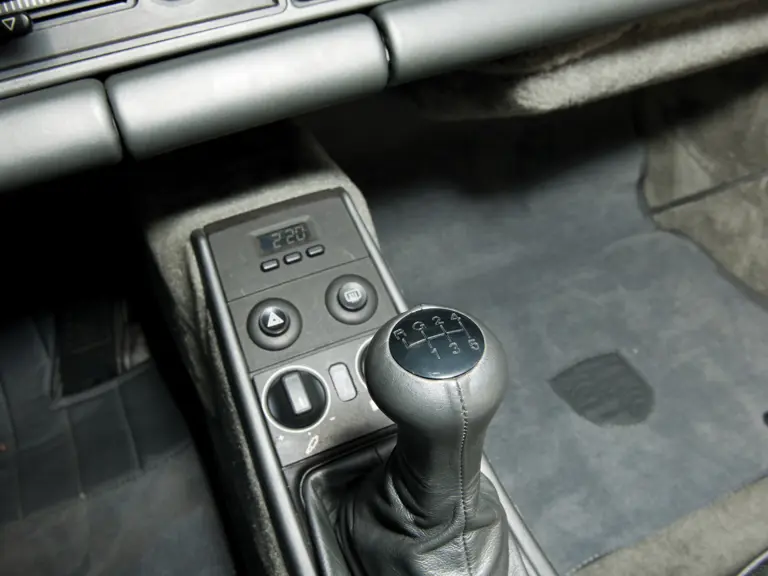
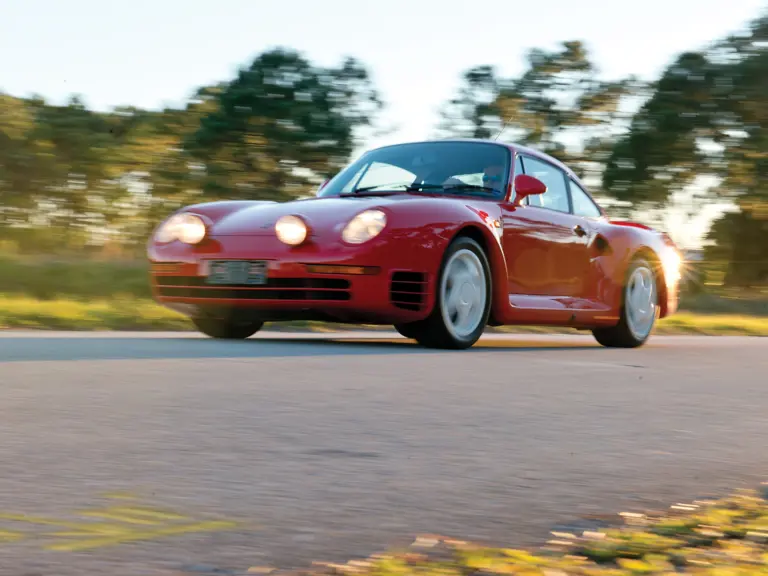
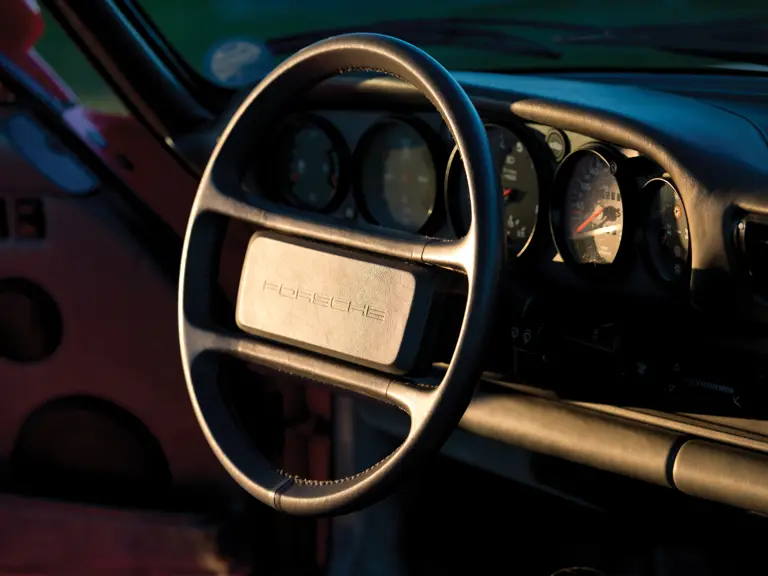
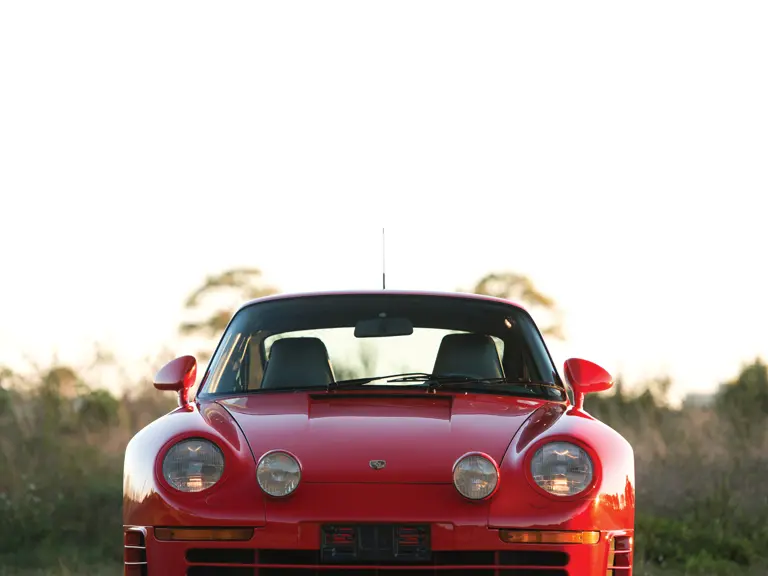


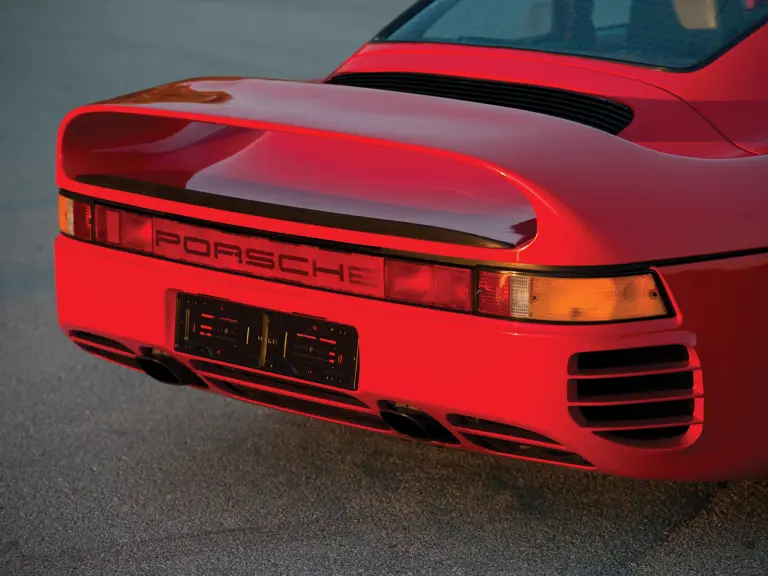
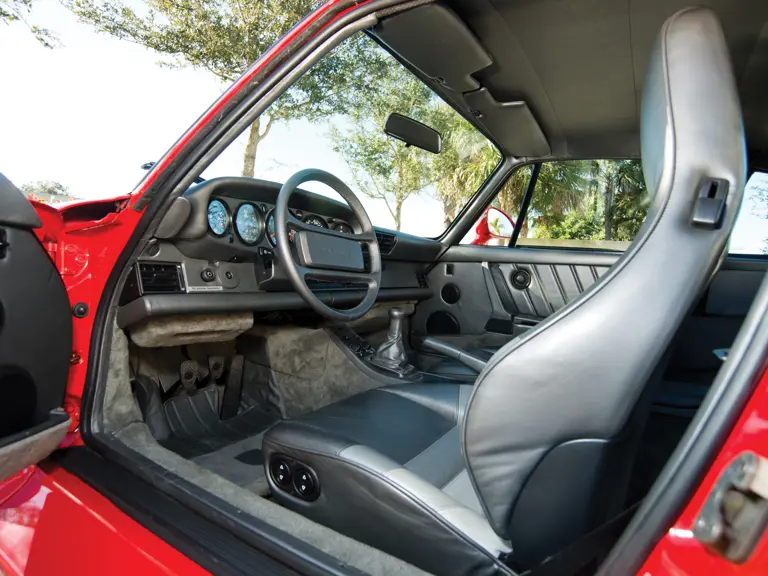
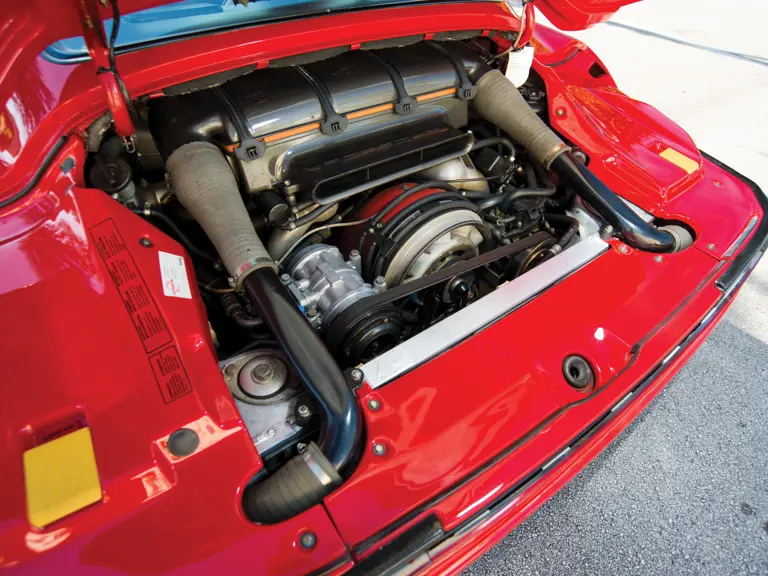
 | Amelia Island, Florida
| Amelia Island, Florida
